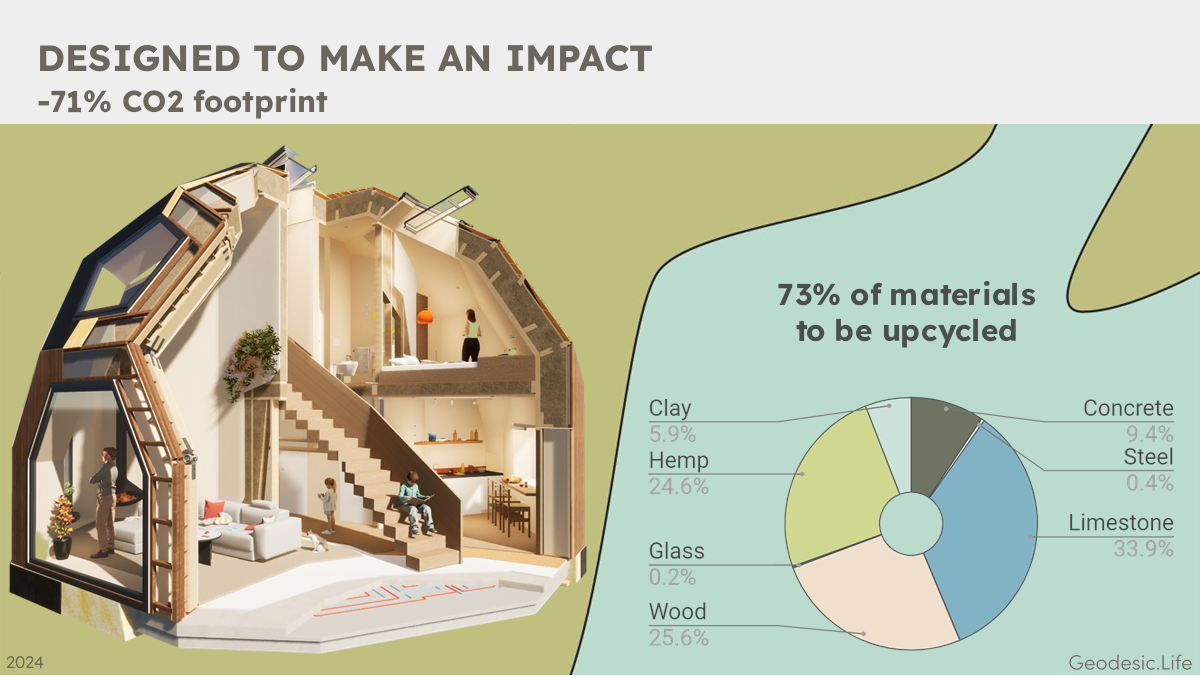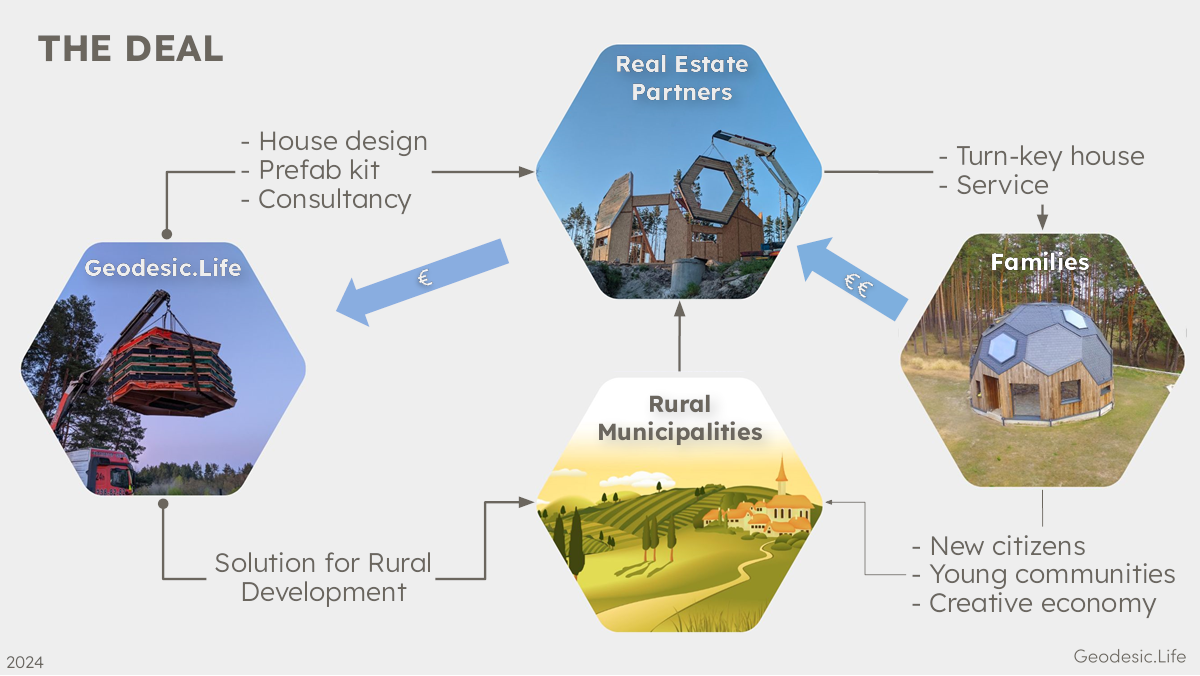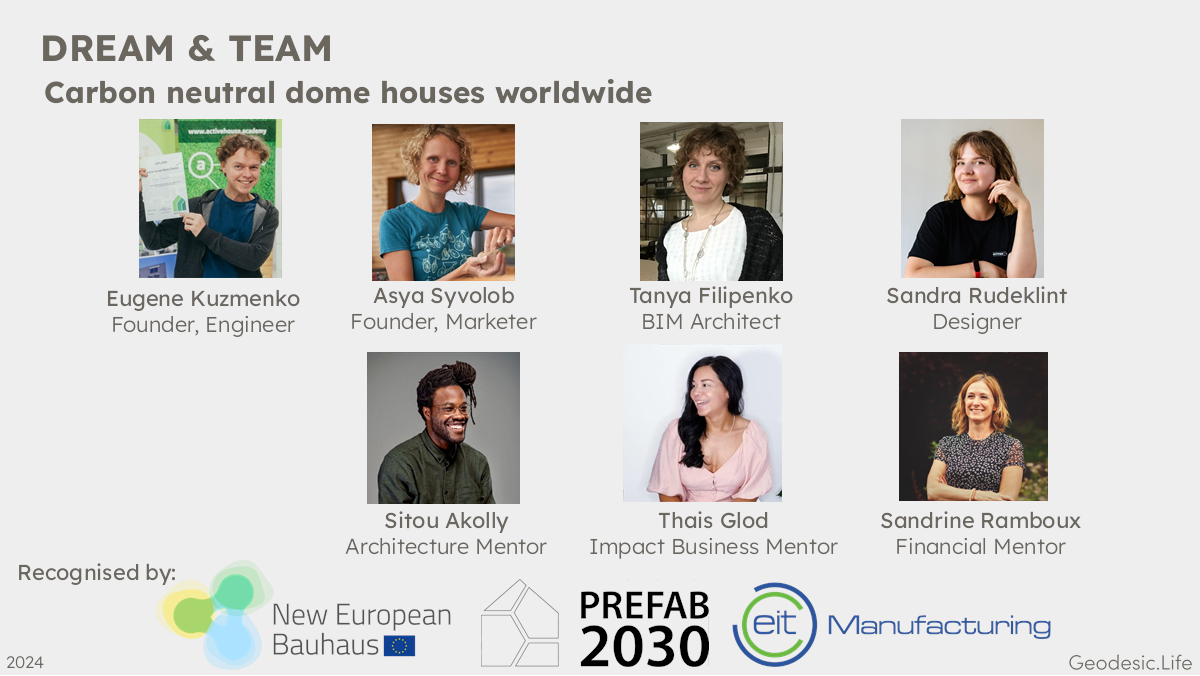Geodesic.Life, a Ukraine-based startup, is challenging the traditional notions of housing by introducing affordable, eco-friendly prefabricated dome homes. This concept addresses two pressing global concerns: the need for accessible housing and the urgency of environmental preservation. By normalizing sustainable living practices, Geodesic aims to make a positive impact on both individuals and the planet. The company just closed a small, $500,000 friends and family round to bring its vision to life.
The startup’s dome homes offer several advantages. They are significantly more affordable than conventional housing options, making them an attractive choice for individuals, families and communities with limited financial resources. The homes are also designed with sustainability in mind: They are constructed using eco-friendly materials, have a low carbon footprint and are energy-efficient. This not only reduces the environmental impact of housing but also aligns with the growing demand for sustainable living solutions.
The startup shared its 13-slide deck with TechCrunch, so let’s dive in and see what we can see.
We’re looking for more unique pitch decks to tear down, so if you want to submit your own, here’s how you can do that.
Slides in this deck
While Geodesic’s deck impresses with its aesthetic design, featuring a tasteful color palette, appealing illustrations and a concise text, it does have some crucial shortcomings.
- Cover slide
- Problem slide 1
- Problem slide 2
- Product image slide
- Solution slide
- What Is Unique? slide
- Designed to Make an Impact slide (composition details)
- Business model slide
- Beachhead market slide
- Competition slide
- Competition slide 2
- ‘ New Age of Rurals’ image slide
- Team slide
A couple of things to love about Geodesic’s pitch deck
Geodesic’s pitch deck was quite impressive, particularly in how it connected problems with solutions, showcasing the company’s innovative approach and commitment to sustainability with solid data.
A clear starting point
[Slide 9] A great, clearly defined beachhead market is a good way to get a toehold for your business. Image Credits: Geodesic.Life
This slide contains useful information, but it lacks some critical details about the targeted market. For instance, Geodesic has yet to identify the specific homebuyers within this sector who will be targeted first. Despite this, the presentation provides a solid overview of what Geodesic aims to capture and positions the company within national, continental and global markets.
This clear contextualization of the target market is essential because the specific focus on “turn-key prefab in the Stockholm area” is relatively modest in scope. However, the opportunity for growth is significant, which should appeal to investors.
Designed to make an impact

[Slide 7] Highlighting how the company is different is a helpful starting point for conversation. Image Credits: Geodesic.Life
Geodesic did a good job with this slide. The way the company linked the problem slide to the solution slide is storytelling at its finest, and it goes to show that you can be creative on this front. Geodesic didn’t just point out a big environmental issue with traditional housebuilding; the company also showed how Geodesic’s innovative approach is a game-changer. This clear and logical flow makes it super easy for investors to grasp both the problem’s scale and the solution’s impact.
Adding specific, measurable data about the environmental benefits of the building methods is also smart. These numbers really back up the claims about reducing carbon footprints and underline the company’s commitment to sustainability. This data-driven angle not only boosts Geodesic’s credibility but also highlights the dedication to making a real difference in the construction industry. It’s obvious that Geodesic isn’t just throwing around a cool idea — it’s putting forward a practical solution with solid environmental results to show for it.
Three things that Geodesic Life could have improved
The deck has several areas for improvement beyond a nearly duplicated competition slide. Additionally, it lacks slides requesting funding and detailing the go-to-market strategy. I would like to elaborate on the following points:
You say “affordable,” I say “show me the price tag”
The absence of pricing information on this deck hinders understanding of both the production costs and homebuyer purchase prices.
Including a pricing slide in your pitch deck is crucial for several reasons, especially when presenting to potential investors, because it touches so many parts of the narrative. Here’s why it matters:
- Building block for your business model: A pricing slide provides clear information about how your startup intends to make money. Investors want to understand your business model and how you plan to generate revenue. Pricing details help them assess the feasibility and profitability of your business.
- Value proposition: It helps validate your value proposition by showing that customers are willing to pay for your product or service at the prices you have set. This indicates market validation and potential for growth.
- Foundation for financial projections: Pricing is a key component of financial forecasts. It affects projections for revenue, which in turn influences profitability, cashflow and break-even analysis. Investors need this information to evaluate the financial viability of your startup.
- Positioning: Demonstrating how your pricing strategy compares to competitors can highlight competitive advantages or justify premium pricing due to better features, benefits or brand positioning.
In short, a pricing slide is not just about showing numbers but is a strategic element that communicates the viability and potential of your business model to investors. It’s an essential part of the story that convinces them why now is the right time to invest in your startup.
The business model comes up short

[Slide 8] This is a brainstorm, not a business model. Image Credits: Geodesic.Life
Closely related to the previous point: Pricing is one side of the business model, but there are many more parts to the puzzle. Geodesic doesn’t do a good job here.
The business model slide is very light on details, and the details that are there are a little confusing. It is difficult to understand the exact idea behind the flow of money through this business. However, it appears that the idea is for developers to build communities of prefabricated constructions. That’s great, but it’s not clear who the customers are for these prefabricated communities. Municipalities may be customers, as they might be interested in building social or affordable housing together with community buildings. However, private developers could also be customers, and perhaps they’re interested in building these communities for sale or rent. Without more information, it is difficult to assess the feasibility of this business model.
Having a solid business model is key to winning over investors. It shows them you’ve got a clear plan for making money and keeping the business growing over the long haul. Investors are all about seeing a good return on their investment, and a sharp business model lays out exactly how your startup will bring in cash, keep costs down and scale up.
By detailing your strategy for getting customers, setting prices and staying ahead of the competition, you’re demonstrating a smart, strategic approach to building a thriving business. This kind of clarity also lowers the risk for investors, as they can see the specific steps you’ll take to hit financial goals.
Too many people and too little info

[Slide 13] Yeah, but who are these folks, and why should I invest in them? Image Credits: Geodesic Life
The team slide in a pitch deck is fundamentally important because it showcases the individuals behind the company, emphasizing their expertise, experience and ability to execute the business plan. For investors, the team’s background and cohesion often outweigh the initial product idea since a strong team is seen as capable of pivoting and adapting to achieve success, even as challenges arise. The team slide provides a snapshot of the collective skills, industry knowledge and entrepreneurial history that the founders and key personnel bring to the table. It helps investors gauge the team’s understanding of the market, their problem-solving capabilities and their commitment to the venture. Therefore, ensuring this slide effectively communicates the team’s strengths is crucial.
For Geodesic, several issues need to be addressed to enhance the effectiveness of the team slide. Including too many people on the slide can dilute the focus from key players who are pivotal to the startup’s success. Limit the slide to core team members — typically founders and key executives — who directly influence major business outcomes.
Also, listing names, photos and job titles does not provide enough context about why these individuals are uniquely qualified to succeed in this venture. Investors need to understand what each team member specifically brings to the table in terms of relevant expertise, past entrepreneurial successes or industry experience.
It’s vital to demonstrate a strong founder-market fit, showing clear reasons why your team, above others, is capable of addressing what the market needs and navigating the complexities of the industry. Include brief highlights of previous roles, startup experience and specific achievements that align directly with the goals and challenges of your current venture. This approach will offer a clearer and more compelling picture of your team’s capabilities, enhancing investor confidence in your company’s potential.
The full pitch deck
If you want your own pitch deck teardown featured on TechCrunch, here’s more information. Also, check out all our Pitch Deck Teardowns all collected in one handy place for you!
techcrunch.com



